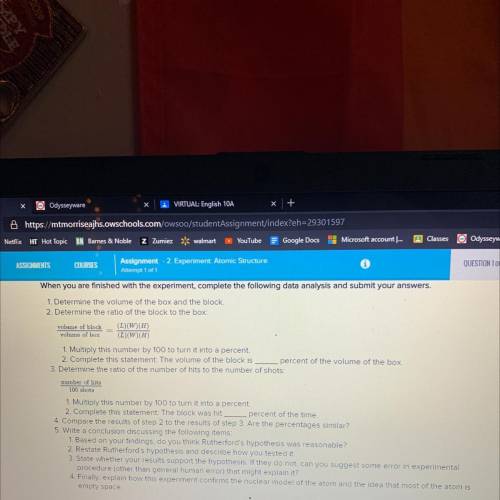
When you are finished with the experiment, complete the following data analysis and submit your answers.
1. Determine the volume of the box and the block.
2. Determine the ratio of the block to the box:
volume of block
(L)(W)(H)
volume of box (L)(
WH)
1. Multiply this number by 100 to turn it into a percent.
2. Complete this statement: The volume of the block is percent of the volume of the box.
3. Determine the ratio of the number of hits to the number of shots:
number of hits
100 shots
1. Multiply this number by 100 to turn it into a percent.
2. Complete this statement: The block was hit percent of the time.
4. Compare the results of step 2 to the results of step 3. Are the percentages similar?
5. Write a conclusion discussing the following items:
1. Based on your findings, do you think Rutherford's hypothesis was reasonable?
2. Restate Rutherford's hypothesis and describe how you tested it.
3. State whether your results support the hypothesis. If they do not, can you suggest some error in experimental
procedure (other than general human error) that might explain it?
4. Finally, explain how this experiment confirms the nuclear model of the atom and the idea that most of the atom is
empty space
mo


Answers: 3
Another question on Biology

Biology, 21.06.2019 20:00
The observations of hooke and van leeuwenhoek documenting the existence of microscopic cells formed the basis of what important theory? a. the cell theory stating that all living things are composed of cellsb. the theory of spontaneous generation, which held that life forms could arise spontaneouslyc. the theory of chemotherapy, or use of antimicrobials to destroy pathogenic organismsd. the germ theory of disease and causative agents
Answers: 1

Biology, 22.06.2019 01:00
Nucleic acid certain protein cell membranes certain carbohydrates
Answers: 1

Biology, 22.06.2019 12:30
The table presents the average day and night temperatures in five cities. it also reveals whether a city receives substantial rainfall (wet climate) or little rainfall (dry climate). which city’s rocks are likeliest to experience frost wedging, and why? a) city a because the consistently subzero temperature would prevent water from melting b) city b because it is a wet region and the temperature fluctuates around the freezing point c) city c because it receives plenty of rain fall and the weather is moderately cool d) city d because the hot and dry weather would cause rocks to absorb water
Answers: 3

You know the right answer?
When you are finished with the experiment, complete the following data analysis and submit your answ...
Questions

Computers and Technology, 09.09.2020 01:01



Mathematics, 09.09.2020 01:01







Mathematics, 09.09.2020 01:01


Mathematics, 09.09.2020 01:01






Mathematics, 09.09.2020 01:01



